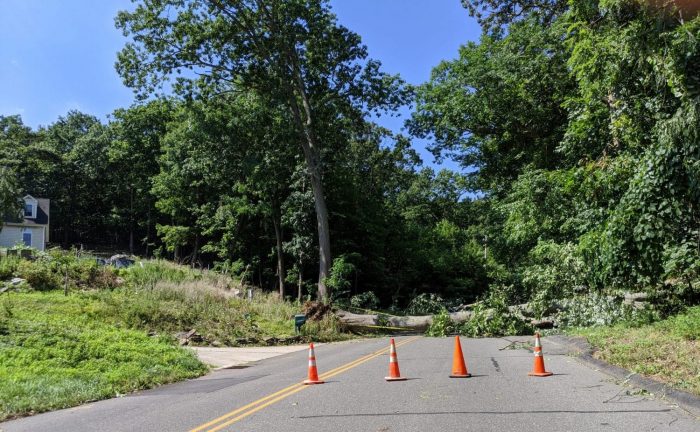PSEG Faces Backlash While it Tries to Restore Power
While crews from several states continued to restore power this week after the outage caused by Tropical Storm Isaias, frustrated residents and politicians expressed their dismay at PSEG for the pace at which they were restoring power and for the communications problems from a storm that passed more than a week earlier.
Indeed, Brookhaven Town Supervisor Ed Romaine (R) characterized PSEG’s response to the storm as “underwhelming” and “disappointing.” He expressed further frustration at the moving target PSEG had for restoring power.
Romaine called on PSEG to give families and businesses that lost power for more than 48 hours $500 to cover the cost of lost food. He also said he plans to send Governor Andrew Cuomo (D) a letter calling for the appointment of an independent arbitrator who could hear the claims of businesses in a “swift” and proper manner.
President and Chief Operating Officer of PSEG Long Island Dan Eichhorn said the company is still discussing any possible reimbursement to customers and hasn’t made a final assessment.
Meanwhile, State Attorney General Letitia James (D) launched an investigation of PSEG in connection with their response to a storm that knocked out power to 420,000 customers.
As of mid-day Tuesday, a week after the storm hit, 3,800 homes were without power directly from the storm. At the same time, PSEG Long Island reported 25,142 total customers without power, which includes new outages after the storm.
Eichhorn acknowledged the call for accountability from local and state leaders.
“We know there’s been a couple of agencies that want to come in and do an investigation and audits,” Eichhorn said in a press conference Sunday night. “The way I would characterize this storm [is that we] did a very good job of preparing for it. Our communications were not up to our expectations. We know that created a lot of angst.”
PSEG, which has operated under the direction of LIPA since 2014, planned to conduct its own internal analysis.
“We do recognize that our communications channels did not meet our customers’ expectations. We’re going to look at that immediately, make fixes” and will improve those processes, Eichhorn said.
PSEG has maintained during the aftermath of Isaias that the communications problems did not impede the company’s ability to restore power and that it brought in numerous additional crews and continued to request additional staff even on Tuesday.
Over the weekend and into the beginning of the week, PSEG Long Island brought in close to 2,000 more lineworkers, tree trimmers and other personnel, bringing the total to over 6,000,
That compares with the Long Island crews and contractors the company operates on a daily basis of about 600 people, bringing the response teams to about 10 times the usual operating staff levels.
Eichhorn said the crews were practicing safe social distancing protocols and were also polled prior to the start of work about how they were feeling. The PSEG executive recognized the frustration residents have felt during the outage.
“We know customers have waited a long time,” Eichhorn said.
Several politicians have threatened consequences for PSEG’s storm response, including Governor Andrew Cuomo (D) who floated the idea of revoking the franchise. Eichhorn suggested the company’s legal team would consider Cuomo’s comments.
Romaine said PSEG sent in four crews to Brookhaven, the largest town by area in the state, the first day and 10 the second. Given the number of downed trees, Romaine said he believes that should have been closer to 30.
Councilman Kevin LaValle (R-Selden) said the area was fortunate this wasn’t a bigger storm because a larger hurricane, with more rain and more intense winds, could have caused more of the population to lose power for a longer period of time.
Residents were upset that they couldn’t talk to somebody at PSEG to get answers.
Starting in 2015, PSEG received $729 million secured by Cuomo over a three-year period to strengthen the resiliency of the electric grid.
Eichhorn said that investment protected many of the customers who would otherwise have lost their power during this storm.
Local leaders, however, didn’t feel so fortunate.
“This is something that was not supposed to happen again,” Assemblyman Steve Englebright (D-Seatuket) said.
Englebright further said his office has heard of numerous problematic situations in restoring power, including in the S section of Stony Brook, where one side of a street had power and the other didn’t. When residents saw a repair truck and expressed their appreciation and excitement about power returning, the crew told them they were “here for the other side of the street” and drove off, Englebright said.
Englebright recognized the context for solutions to the ongoing problem of restoring power after major storms, including hurricanes that could come during this active season later this year.
He urged a short term plan, in which the area could return to the way things stood the week before last, and a long term plan, which could include more than cutting overhanging branches before storms wreak havoc.
Englebright and Romaine urged the area to consider burying some vulnerable lines. Romaine suggested burying one to two percent of the lines for the next several decades, increasing the resilience of the grid.
This storm serves as a wake-up call for the area, said Englebright, who lost power for four days and whose mother in Stony Brook lost power for five days.
To prepare for the storms that may come later this year, Long Island should have fuel depots with generators that are fitted for gas stations to prevent a shortage of gas, which occurred in the aftermath of Superstorm Sandy, Englebright said. He also urged greater preparation for people who are home bound and who need special medicine.







